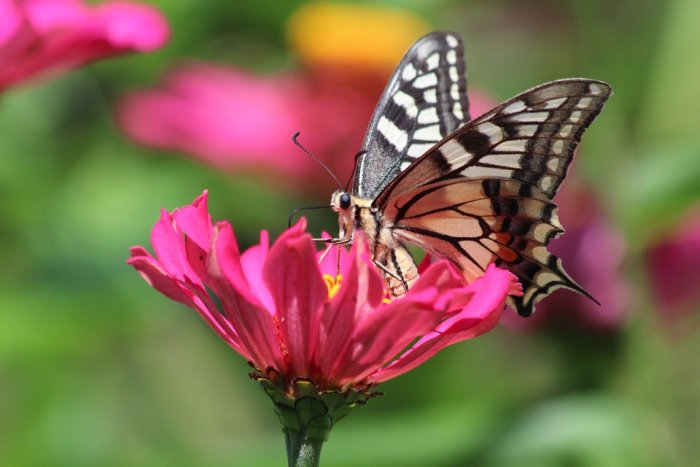Ahimsa – Ancient Non-Violence Concept Teaching Compassion And Love Towards All Living Beings
Ellen Lloyd - AncientPages.com - Ahimsa is an ancient multidimensional concept strongly emphasizing the importance of non-violence and compassion towards all living beings.
Not causing injury includes not only one’s actions but also thoughts and words. The Ahimsa concept is based on the belief that all living creatures have the spark of divine spiritual energy. This means that if you hurt someone, then you ultimately hurt yourself and violence has karmic consequences.
Left: The hand with a wheel on the palm symbolizes the Jain Vow of Ahimsa. The word in the middle is "Ahimsa". Image credit: Stock photo - Middle: Planet Earth. Image Credit: Public Domain - Right - Statue of Mahavira, The torch-bearer of Ahimsa. Image Credit: Public Domain
Ahimsa plays an important part in Jainism, Hinduism, and Buddhism. Many prominent figures strongly believed in practicing Ahimsa, one of them was Mahatma Gandhi (1869-1948) who before becoming a victim of assassination inspired movements for civil rights and freedom across the world.
Ahimsa – Main Pillar of Jainism
The practice of Ahimsa is especially strong among Jains. In Jainism, an ancient religion from India the goal is to achieve the liberation of the soul. This is accomplished through reincarnation.
Like Buddhists, Jains believe in reincarnation, but Jainism is based on stricter ascetic beliefs. According to Jainism, all animals and plants, as well as human beings, contain living souls. All of these souls are equal in value and everyone must be treated with the same respect. Ahimsa’s not harming concept applies not only to humans and larger animals, but also to insects, plants, and microbes.
Jains are strict vegetarians and many refrain from eating root vegetables such as potatoes and onions. This is because consuming the root of a plant means the whole plant dies. Jains can eat the leaves of a plant, but not root vegetables.
Violence in Jainism is only tolerated in self-defense and life-threatening situations.
View Of Ahimsa In Buddhism And Hinduism
Ahimsa is an important concept in Buddhism and Hinduism. However, the observance of ahimsa is not so strict as in Jainism. Emperor Ashoka (304 B.C. – 232 B.C) was an Ahimsa follower. Ashoka believed that all living beings should enjoy security, peace, happiness, and live in freedom. He preached vegetarianism and in his inscriptions of the 3rd century BCE, stressed the sanctity of animal life.
Ahimsa under Hinduism tolerate violence but under special circumstances. Wars must be avoided. Conflicts should be solved through sincere dialogues. Force must be the last resort.
According to Hindus, Ahimsa is not meant to imply pacifism. Using violence in self-defense is allowed, and Hindu scriptures support the use of violence against an armed attacker. This means that criminals are not protected by the rule of Ahimsa.
Morihei Ueshiba, the founder of Aikido stressed that we live in a world full of provoking people and some will out of ignorance, error, or fear, attack other persons or intrude into their space, physically or verbally. Self-defense under Ahimsa is therefore allowed to neutralize the aggression of the attacker and avoid conflict.
Buddhists disapprove of killings because such deeds can result in ending up in the realms of hell. As previously discussed in Ancient Pages, Diyu is the Chinese version of hell partly based on the Buddhist concept of Naraka. According to Chinese beliefs, there is no way to avoid going to Diyu. Everyone who dies must end up in Diyu, but the length of the visit depends on the severity of the sins one committed. It is God Yama who decides when the being’s soul has finished the punishment and can pass from one stage to another.
All life-forms have souls and must be respected, according to the teachings of Ahimsa. Image Credit: Public Domain
Ahimsa is also one of the first disciplines every Yoga student must learn. It is required to be mastered in the preparatory stage (yama), the first of the eight stages that lead to perfect concentration.
Ahimsa can be regarded as part of a religion, but it is also a way of life. As Mahatma Gandhi pointed out, “Ahimsa is in Hinduism, it is in Christianity as well as in Islam.”
"Nonviolence is common to all religions, but it has found the highest expression and application in Hinduism (I do not regard Jainism or Buddhism as separate from Hinduism),” he added.
It’s never wrong to show kindness and Ahimsa reminds us that life and our world would be much better if we did not harm each other and other living beings. Ahimsa simply teaches love and compassion towards all life. It’s something everyone can practice, regardless of religion.
Written by Ellen Lloyd – AncientPages.com
Copyright © AncientPages.com All rights reserved. This material may not be published, broadcast, rewritten or redistributed in whole or part without the express written permission of AncientPages.com
Expand for referencesAltman N, Ahimsa: Dynamic Compassion: A Nonviolence Anthology
Supriya Kelkar, Ahimsa
More From Ancient Pages
-
 1,500-Year-Old Tunnel Tomb With Human Remains And Artifacts Accidentally Unearthed In Japan
Archaeology | Feb 23, 2018
1,500-Year-Old Tunnel Tomb With Human Remains And Artifacts Accidentally Unearthed In Japan
Archaeology | Feb 23, 2018 -
 Mysterious Bronze Age ‘Golden Tomb’ Unearthed In Armenia
Archaeology | Mar 3, 2023
Mysterious Bronze Age ‘Golden Tomb’ Unearthed In Armenia
Archaeology | Mar 3, 2023 -
 Rare Pre-Columbian Archaic Settlement Discovered In The Dominican Republic May Solve A Caribbean Mystery
Archaeology | Apr 12, 2022
Rare Pre-Columbian Archaic Settlement Discovered In The Dominican Republic May Solve A Caribbean Mystery
Archaeology | Apr 12, 2022 -
 Unexplained Encounters With Invisible Barriers – Mysterious Rays And Energy Fields
Featured Stories | Jul 17, 2018
Unexplained Encounters With Invisible Barriers – Mysterious Rays And Energy Fields
Featured Stories | Jul 17, 2018 -
 Modern Pesticide Accelerates Corrosion Of Ancient Roman Bowl
Archaeology | Oct 6, 2022
Modern Pesticide Accelerates Corrosion Of Ancient Roman Bowl
Archaeology | Oct 6, 2022 -
 Millennium Old Dice Found In Vadnagar, Gujarat, India
Archaeology | Apr 25, 2022
Millennium Old Dice Found In Vadnagar, Gujarat, India
Archaeology | Apr 25, 2022 -
 Something Unexplained Is Happening In Ancient English Caves – Reports From Numerous People
Featured Stories | Oct 22, 2024
Something Unexplained Is Happening In Ancient English Caves – Reports From Numerous People
Featured Stories | Oct 22, 2024 -
 Surprising Discovery Of Nabataean Underwater Temple In Puteoli, Italy
Archaeology | Sep 23, 2024
Surprising Discovery Of Nabataean Underwater Temple In Puteoli, Italy
Archaeology | Sep 23, 2024 -
 Ancient Mesoamerican Board Games ‘Patollis’ Discovered In Mexico
Archaeology | Sep 9, 2024
Ancient Mesoamerican Board Games ‘Patollis’ Discovered In Mexico
Archaeology | Sep 9, 2024 -
 Carian Princess’ Tomb, Golden Artifacts – Now On Display In Renovated Hall Of Bodrum Castle
Artifacts | Aug 27, 2020
Carian Princess’ Tomb, Golden Artifacts – Now On Display In Renovated Hall Of Bodrum Castle
Artifacts | Aug 27, 2020 -
 What Was Life Like For Children In Ancient Athens?
Ancient History Facts | Jul 4, 2018
What Was Life Like For Children In Ancient Athens?
Ancient History Facts | Jul 4, 2018 -
 Sogdian Temple Of Jartepa II On Caravan Road Of The Silk Road
News | Sep 3, 2020
Sogdian Temple Of Jartepa II On Caravan Road Of The Silk Road
News | Sep 3, 2020 -
 Tomb Of A 1,000-Year-Old Sican Surgeon Wearing A Golden Mask Discovered In Peru
Archaeology | Mar 30, 2022
Tomb Of A 1,000-Year-Old Sican Surgeon Wearing A Golden Mask Discovered In Peru
Archaeology | Mar 30, 2022 -
 Extraordinary 1,000-Year-Old Viking Sword Discovered In Cork, Ireland
Archaeology | Sep 29, 2017
Extraordinary 1,000-Year-Old Viking Sword Discovered In Cork, Ireland
Archaeology | Sep 29, 2017 -
 Early Expansion Of Homo sapiens: Underwater Caves Give New Clues About Sicily’s First Residents
Underwater Discoveries | Oct 15, 2024
Early Expansion Of Homo sapiens: Underwater Caves Give New Clues About Sicily’s First Residents
Underwater Discoveries | Oct 15, 2024 -
 Samurai Swords: Katana And Wakizashi And Their Long Tradition
Ancient Traditions And Customs | Aug 6, 2018
Samurai Swords: Katana And Wakizashi And Their Long Tradition
Ancient Traditions And Customs | Aug 6, 2018 -
 On This Day In History: Anne Boleyn, The Second Wife Of Henry VIII – Beheaded For Adultery, Treason And Incest – On May 19, 1536
News | May 19, 2016
On This Day In History: Anne Boleyn, The Second Wife Of Henry VIII – Beheaded For Adultery, Treason And Incest – On May 19, 1536
News | May 19, 2016 -
 On This Day In History: Unua Libro ‘First Book’ Describing Esperanto Published – On July 26, 1887
News | Jul 26, 2016
On This Day In History: Unua Libro ‘First Book’ Describing Esperanto Published – On July 26, 1887
News | Jul 26, 2016 -
 The Hittites, Mysterious People Of A Thousand Gods – Collapse Of The Hittite Empire
News | Sep 9, 2015
The Hittites, Mysterious People Of A Thousand Gods – Collapse Of The Hittite Empire
News | Sep 9, 2015 -
 Highly Advanced Robots In Ancient China
Ancient Technology | Aug 7, 2015
Highly Advanced Robots In Ancient China
Ancient Technology | Aug 7, 2015


